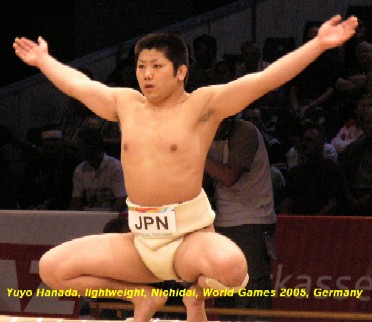
![]()
Amateur Sumo – the sport as it should be
Mark Buckton
Sakai World Sumo Champs – not all about winning
Las Vegas Koen
Joe Kuroda
Our man reports from the fight capital of the world
Rikishi of Old
Joe Kuroda
A look at a rikishi of yesterday with Kotozakura – our man for October
Heya Peek
John Gunning
John’s early morning dash to Azumazeki-beya & report on TKOTU
SFM Interview
Katrina Watts sits down with SFM’s Mark Buckton to discuss amateur sumo
Photo Bonanza
SFM’s best yet – Aki Basho/ Las Vegas / Amateur World Champs / Azumazeki-beya visit – seen nowhere else
Aki Basho Review
Lon Howard
Lon gives us his Aki Basho summary, along with the henka sightings results, and his take on the tournament while ‘gem’ of the basho takes a break
Lower Division Rikishi
Mikko Mattila
Mikko Mattila returns to cover lower division ups and downs
Kyushu Basho Forecast
Pierre Wohlleben & Mark Buckton
Pierre predicts the Kyushu Basho banzuke while Mark previews the ones to watch next time out
Sumo 101
Barbara Ann Klein
Discovers and explains amasumo & ozumo variations
Kimarite Focus
Mikko Mattila
Mikko once again walks us through his chosen kimarite
Minusha
John McTague
John’s unique bimonthly view of news from outside the dohyo
Online Gaming
Zenjimoto of ‘game fame’ covers some of the very best sumo games around – his own!
Kokugi Connections
Todd Lambert
Todd’s focus on 3 of the most interesting online sumo sites today
Fan Debate
Is the limit on foreign rikishi fair? See what our debaters had to say
SFM Cartoons
Benny Loh
In the first of our cartoon bonanzas, sit back and chuckle at Benny Loh’s offerings
Let’s Hear From You
What was it that made you a sumo fan? Gernobono tells all
Readers’ Letters
See what SFM readers had to say since our last issue
Sumo Quiz
The Quizmaster
Answer the Qs and win yourself next basho’s banzuke.
A very major and tremendously important difference between pro- and ama-sumo is amateur sumo’s enforcement of anti-doping rules as set forth by the International Olympic Committee under its Medical Code. While charges of steroid use in pro-sumo abounds in some online discussions, there is no policy concerning this matter in Ozumo. In amateur sumo, however, the anti-doping code was adopted by the International Sumo Federation (ISF) in early 2000, with the result that anti-doping tests are
Unlike Ozumo, amasumo has weight classes. The international division standards are as follows:
In addition, there are weight classes for Juniors – under 18 years of age. They are:
An “Open” division carries no weight restrictions or limitations.
Another significant departure from pro-sumo is the manner of dress. Not of the wrestlers – although they are allowed to wear short tights (not unlike bicycle shorts) under their mawashi, and, for women, cover-up tops. The dress rules for amasumo gyoji and judges, however, are as different from pro-sumo as they can be. While most of us are used to the very colorful gyoji robes, the black hat and the ornate gunbai of Ozumo, the amasumo gyoji (who is still called gyoji in the IFS Regulations on Refereeing), is required to wear white trousers, soft white shoes, a white shirt and a black bowtie. On the other
Next Home

Photograph by Meike Sinke
